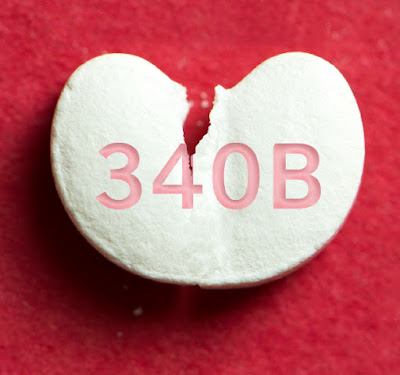By: Brandon M. Macsata, CEO, ADAP Advocacy
Jen Laws, President & CEO, Community Access National Network
The 340B Drug Pricing Program (“340B”) is probably one of the most transformative public health programs providing lifesaving supports and services to people living with HIV in the United States, second only to the Ryan White HIV/AIDS Program (“RWHAP”). As such, rigorous debate about the future of the program is not only healthy, but it is also paramount to its success. As patients (and patient advocates), it is our responsibility to demand accountability, transparency, and stability. There is universal agreement about the vital role 340B plays in improving access to healthcare. But for many – including ADAP Advocacy and the Community Access National Network – we contend that the program could be doing more…and better! The focus of the program should be on the patients, and not the Covered Entities, medical or service providers, or any other business enterprises making lots of money off it. That is the inconvenient truth behind why we need to reform this vital safety net program.
 |
| Photo Source: CANN |
Section 340B of the Public Health Service Act (PHSA) is a Drug Pricing Program established by the Veterans Health Care Act of 1992. That year, Congress struck a deal with pharmaceutical manufacturers to expand access to care and medication for more patients; if pharmaceutical manufacturers wanted to be included in Medicaid’s coverage, then they’d have to offer their products to outpatient entities serving low-income patients at a discount. The idea was brilliantly simple. Drug manufacturers could have a guaranteed income from participation in the Medicaid program and Covered Entities could have guaranteed access to discounted medications. Congress set-up a payment system by way of rebates and discounts affording certain healthcare providers a way to fund much needed care to patients who could not otherwise afford it.
“…to stretch scarce Federal resources as far as possible, reaching more eligible patients and providing more comprehensive services.”
H.R. Rep. No. 102-384(II), at 12 (1992)
THAT is the legislative intent behind 340B. THAT is where some of us want to return 340B’s focus. THAT is why reform is coming!
Ironically, critics of the 340B reform movement – often motivated by self-preservation and protecting their ever-expanding budget and geographic footprint – are quick to attack the idea of the need for reforms. Sadly, they’re also quick to turn their criticism into personal attacks, including questioning the intentions, morals, and character of the people supporting reform. They charge, using Inspector Clouseau “gotcha” style rhetoric, that we’re in the “pockets” of the drug manufacturers because we accept their money to help with our patient advocacy and education (yet there is no “gotcha”, since this information is quite publicly available on our websites, annual tax returns, Guidestar, as well as frequent public commentary).
Isn’t it funny how the “gotcha” mentality cannot accept the obvious, that maybe our interests align with the drug manufacturers because it is in the best interest of the patients. Drug manufacturers make products patients want and need. Ensuring funding flows in a way that expands patient access to medications does indeed benefit both patients and the drug manufacturers. It should be noted, this criticism tends to also neglect mentioning the interests of the entities challenging reform: anti-competitive consolidation among hospitals and pharmacies (leaving whole areas without services), increasing profits, paying for salaries unrelated to healthcare, and increasing administrative salaries are all excellent examples of why we’re left asking “Who is actually benefiting from this program?”
The truth of the matter is, aside from a growing list of patients, patient advocacy organizations, and drug manufacturers, there is a growing chorus calling for reform. Academia wants it (NEJM, Penn LDI, USC Schaeffer), economists want it (Nikpay, Gracia), national trade associations want it (NACHC, NTU), policy think tanks want it (CMPI, NAN), and even multiple news media outlets are suggesting it (Forbes, NYT, WSJ). Local activists are also increasingly fed-up with what they’re witnessing (Dinkins, Feldman, Winstead).
Dr. Diane Nugent, Founder & Medical Director of the Center for Inherited Blood Disorders, recently noted an opinion piece in the Times of San Diego, “A September 2022 analysis by the Community Oncology Alliance revealed that some hospitals participating in 340B price leading oncology medications nearly five times more than the price they paid. Another study found that hospital systems charge an average of 86% more than private clinics for cancer drug infusions.”
But speaking of deep pockets, isn’t it also an inconvenient truth that the very folks fighting reform, and fighting improving the program so patients can benefit more directly from it, are the same folks financed by big hospital systems, and mega service providers abusing 340B intent?
A question often asked by advocates learning about 340B: “So, exactly how much money are we talking about here?”
 |
| Photo Source: Business 2 Community |
Well, we don’t really know…sort of. For Federal Grantees covered under 340B, their grant contracts require accounting of 340B rebates as part of their programmatic revenues. Those revenues are required to be re-invested in the program, which generated the income. This level of transparency is pretty much a “gold standard” that other Covered Entities (less maybe hemophiliac centers) in the 340B space are required to meet. That’s part of why we, and other advocates, are calling on minimum reporting requirements for hospitals, contract pharmacies, and pharmacy benefit managers (insurers covering medications) to begin providing some data. Clearing up the murkiness, if you will. What we do know is drug manufacturers reported more than $100 BILLION in 340B-related sales last year.
That’s concerning especially because “charity care” is declining and medical debt is a growing issue for more and more patients and their families. The Affordable Care Act mandated “charity care”, or “financial assistance”, to be offered by non-profit hospitals seeking to qualify as 340B entities but did not place any definitions behind the mandate, including any “floor” of how much charity care a hospital has to offer.
Now, in all rhetoric opposing any type of transparency in 340B, hospitals tend to conflate their “uncompensated care” and “unreimbursed care” or “off-sets” for public health programs – these don’t necessarily reflect any “charity” being provided to patients. These things should be separated when considering what benefit hospitals provide a community. And under that lens, things get kind of ugly with far too many of the 340B hospitals reporting providing less than 1% of their operating costs as charity. When reviewing how much hospitals write off in bad debt, or going after patients who can’t afford care, often far exceeding those charity care levels, we’re left asking if the “non-profit” designation is really a declaration of concentrating “profits” by way of salaries to top executives rather than formal shareholders?
That bad debt shows up for patients as medical debt. And we need to be very specific here: according to the Urban Institute, some 72% of patients with medical debt owe some or all of that debt to hospitals. Meaning, what we call medical debt is really hospital debt. The situation is unarguably bad. This year alone the Los Angeles County Office of Public Health issued a report outlining for policymakers the role and responsibility hospitals have in driving medical debt and how increasing charity care might stem this problem.
 |
| Photo Source: Business Insider |
As patients, and frankly as patient advocates who represent thousands like us, medical debt isn’t an issue that can be swept under the carpet. Entire communities avoid necessary care to protect their financial interests. We’ve personally watched our friends open GoFundMe accounts to cover medical expenses. We’ve helped our loved one’s cover food and light bills to not miss a medical bill. We also well recognize how negative credit reporting from medical debt can hurt people from getting rental housing or a car loan, or even simple necessities. And when thinking about how much we don’t know about what’s behind that $100 billion price tag, the fact that patients face these concerns on the regular is pretty obscene.
We do know there are plenty of good actors in the 340B space. Particularly, Federal Grantee Covered Entities, like Ryan White Clinics and AIDS Drug Assistance Programs (ADAPs). And we know they’re generally great actors because of that transparency in reporting and the oversight offered by their grant contracts. Ultimately, we’re not necessarily asking for a whole lot more than that for literally everyone else who stands to make a buck in the chain between drug manufacturers and patients. Indeed, that trust on Federal Grantees, particularly Ryan White Clinics and ADAPs, is part of why drug manufacturers restricting 340B sales held a carve out for these Federal Grantees. (To be fair and without much public fanfare, years ago, we – as in ADAP Advocacy and CANN – helped to negotiate these carve-outs as part of our advocacy. Our relationship with drug manufacturers isn’t a one-way street as detractors might try and sell you on.
$100 billion is a lot of money! Is it too much to ask, “Why aren’t patients benefiting more directly from this ever-growing healthcare program?” Facts show that 340B revenues are soaring year after year, yet against the grim backdrop of consistently declining charity care in the impoverished communities needing the most help. To make matters worse, rising medical debt is crushing families. Patients deserve better. People living with HIV who depend on the RWHAP and 340B deserve better! And THAT is why we need reform.
Read our policy reform suggestions here.
Disclaimer: Guest blogs do not necessarily reflect the views of the ADAP Advocacy Association, but rather they provide a neutral platform whereby the author serves to promote open, honest discussion about public health-related issues and updates.

No comments:
Post a Comment